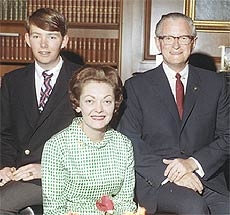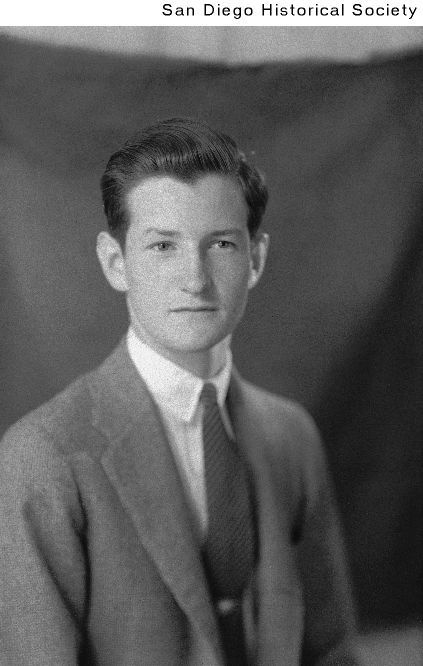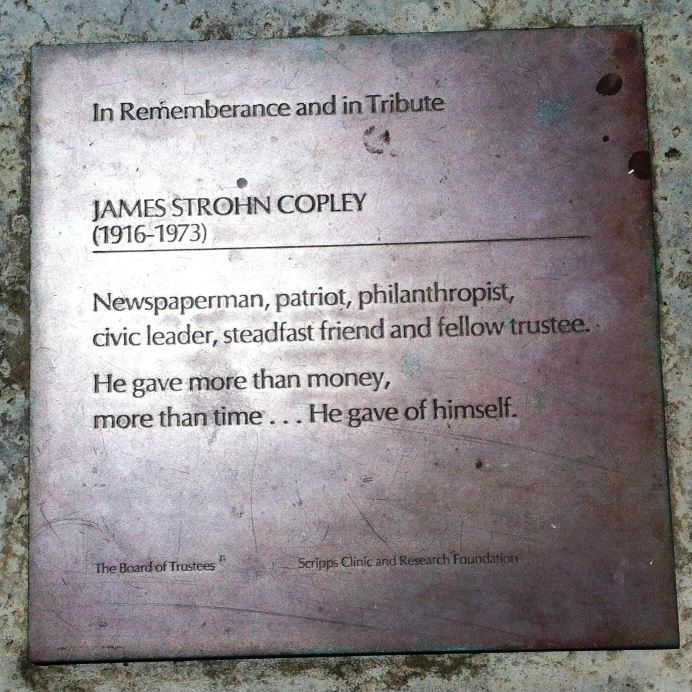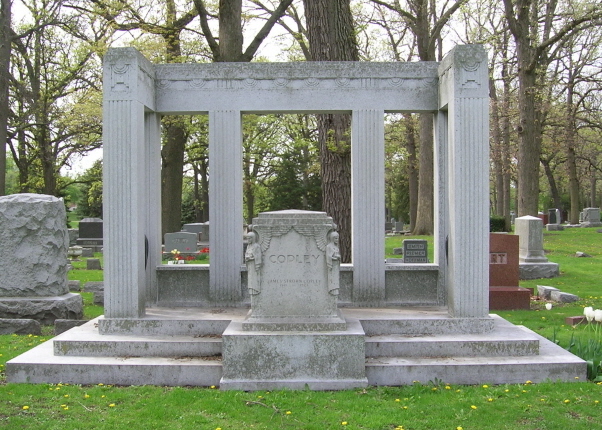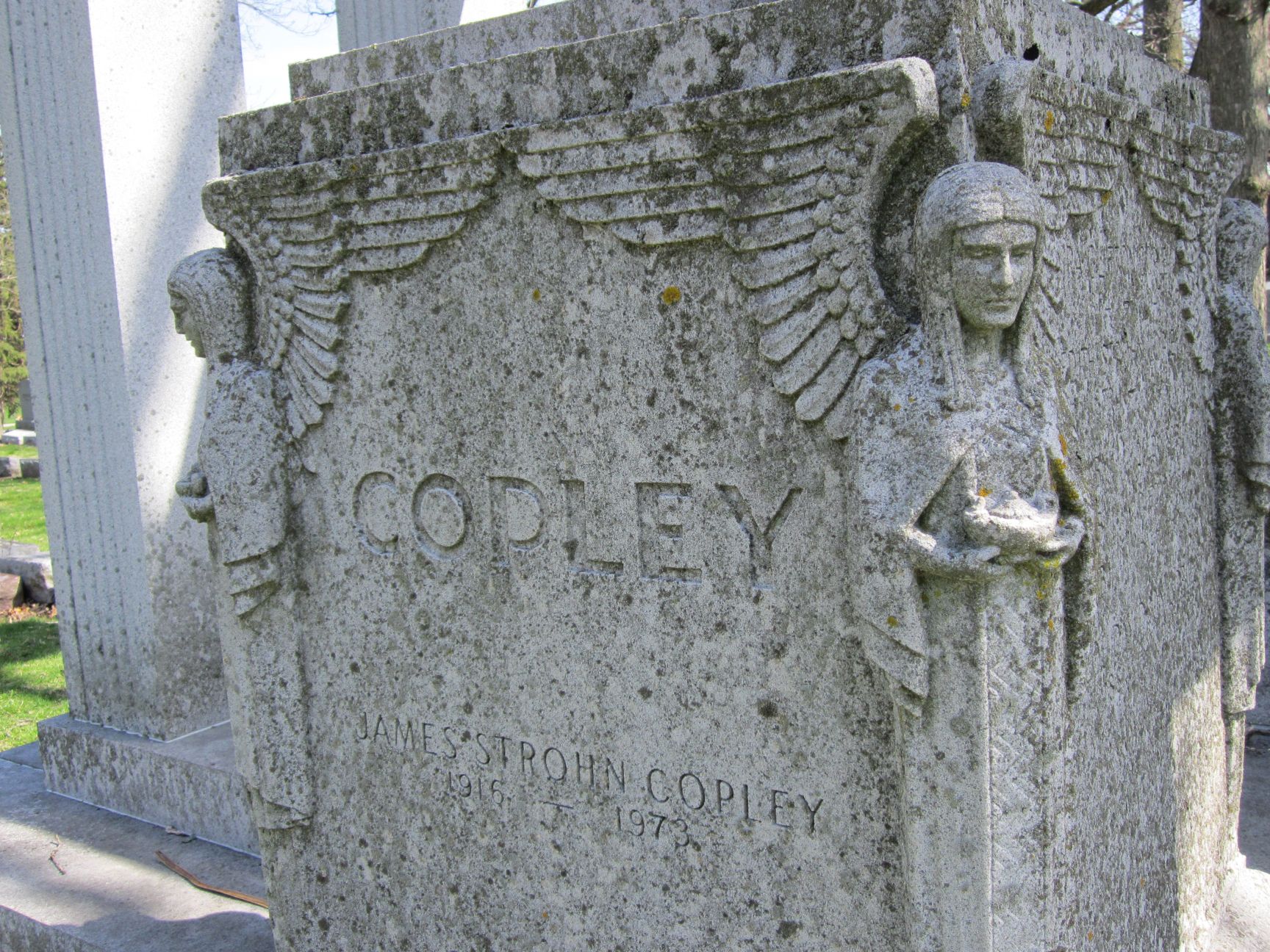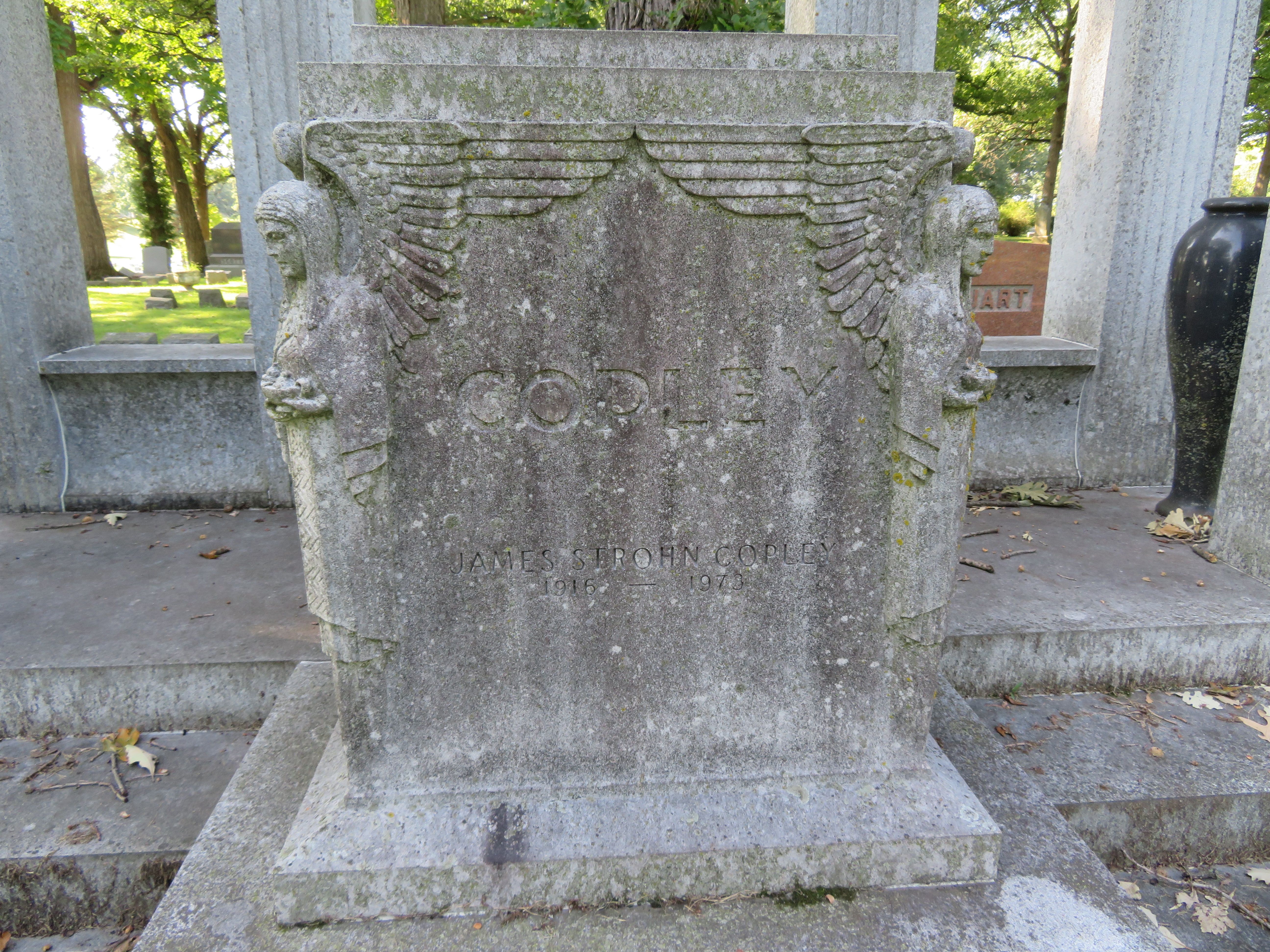From the San Diego History Center:
James Copley was born in St. Johnsville, N.Y., on Aug 12, 1916. His biological parents John and Flora Lodwell. died during the influenza epidemic that swept through the United States in 1917 and 1918.
In 1920 when he was 4 he was adopted by Colonel Ira C. Copley and his first wife, Edith Strohn Copley. Col. Copley bought The San Diego Union and Evening Tribune from the Spreckels family in 1928.
Copley graduated from Yale in 1939 and started his journalism career at another of his father's papers, The Culver City Star News, where he solicited ads and circulation as well as sweeping the floor and writing news stories.
When the elder Copley died in 1947, Jim became Chief Executive Officer of the corporation publishing a large family of newspapers, the flagship of which was, and is today, the Union-Tribune. He pursued a dynamic program of expansion of the newspaper plants, both technologically and in size. He took an active personal interest in the editorial quality of his papers. In the 26 years he headed the enterprise until his death in 1973, the Union's circulation tripled and the Union-Tribune moved into a wholly new plant with new presses in Mission Valley.
Copley's politics were unabashedly conservative, Republican and pro-American, and still have a deep influence on the voting populace of San Diego.
He was President of the Boy Scouts San Diego County Council, the Navy League San Diego Council, and received so many industry and patriotic awards that they are too numerous to list here. He also was a notable philanthropist to local causes, including large, key gifts to build the Copley Auditorium at the San Diego Museum of Art and Copley Library at University of San Diego.
His widow, Helen K. Copley, has continued the tradition of philanthropy through gifts to finance Copley Symphony Hall and the City-County Animal Shelter.
_________________________________
From: Media Museum of Northern California
James Strohn Copley, a giant voice of American journalism, died of cancer Oct. 6, 1973, at the Scripps Clinic and Research Foundation in La Jolla at the age of 57.
He was chairman of the corporation publishing Copley Newspapers in California and Illinois. He also was chairman of the board of Copley News Service, publisher of The San Diego Union and Evening Tribune and editorial page editor of The Union, the "flagship" of his publishing empire.
His death stirred a shockwave of sorrow and sympathy throughout the world.
After attending Phillips Academy at Andover, Mass., from 1930 to 1935, James Copley was graduated from Yale University in 1939 with a Bachelor of Arts degree.
He subsequently was awarded an honorary Doctor of Laws degree by Chapman College in 1966.
He began his newspaper career in 1939, joining the Culver City, Calif., Star-News on the advice of his father, an Illinois utility executive, congressman and publisher.
The elder Copley had entered the newspaper business by acquiring the Aurora, Ill. Beacon in 1905. He purchased a number of Southern California newspapers in 1928, including The San Diego Union and Evening Tribune, which were owned by the J.D. and A.B. Spreckels Investment Co.
Also in the group was the Culver City Star-News. The Culver City paper, Col. Copley told his son, "is small enough so that you can see the trunk and all of the branches."
Young Copley inaugurated his career literally at ground level, sweeping floors after press runs, soliciting circulation and performing other chores when he was not understudying the editorial aspects of the profession, to which he was always particularly attracted.
After two years at Culver City, Jim continued his apprenticeship briefly at the Alhambra, Calif., Post-Advocate and the Glendale, Calif. News-Press before going to San Diego in 1941.
James Copley's blossoming newspaper career was interrupted by Pearl Harbor, following which tragedy he entered the U.S. Naval Reserve.
He served throughout the conflict and returned to inactive duty in 1945 as a lieutenant. He was promoted to lieutenant commander in 1954, to commander in 1957 and to captain in 1965.
For the remainder of his life Jim remained active in the Navy League.
In the meantime, Jim was named to the board of directors of The Copley Press in 1942 and vice president on Sept. 3, 1946, upon his return from maritime service.
Col. Ira C. Copley died on Nov. 2, 1947. Each of his adopted sons, James and William, inherited four-ninths of his estate.
In 1959, James Strohn Copley assumed sole interest in theestate of his stepmother.
As the chief executive officer of the corporation, Jim pursued a dynamic program of growth and expansion. Additionally, he took an active and personal interest in both the editorial quality and technical character of each newspaper.
Through his great interest in technical progress, The Sacramento Union, which he purchased in 1966, within months became the largest U.S. daily utilizing the offset printing process and many other technological innovations.
In the same vein, at the time of his death, Jim had completed one of the most modern and technologically advanced newspaper plants in the world to publish his two San Diego dailies. In editorial terms, Jim was an outspoken, forthright champion of the United States of America.
His vigorous editorial voice, projected by 15 daily and 32 weekly newspapers, urged preservation of constitutional principles, a strong national defense policy, efficiency in government, prudent fiscal policies, a republican federal structure and integrity in elected representation.
He was adamant in his insistence that news offered by Copley Newspapers and Copley News Service be chronicled truthfully, impartially and thoroughly.
To assist in reaching these goals, Jim inaugurated the "Ring of Truth" annual awards for excellence in reporting, editing and news photography.
A complementary post-college career-training program for young journalists was another of his pioneering efforts, which has been frequently emulated.
Copley's philosophy is succinctly stated in his widely distributed creed:
"The newspaper is a bulwark against regimented thinking. One of its duties is to enhance the integrity of the individual which is the core of American greatness."
Copley insisted that his publishers must be autonomous so that each of his newspapers could develop a distinctive personality to best serve their community.
He believed the function of the larger corporation was to improve the quality, service and efficiency of individual publications by offering them greater resources and talent. His dedication to his profession, his services to his country and his involvement in the affairs of his hometown earned him broad recognition.
He was a past president of the Inter American Press Association, a director of the Associated Press, a director of the American Newspaper Publishers Association Bureau of Advertising, a past member of the board of the American Newspaper Publishers Association, past president of the ANPA Research Institute, a member of the American Society of Newspaper Editors, and the National Press Club.
Copley was a national figure in Sigma Delta Chi, the professional journalistic society. In 1951 he was national honorary president and addressed the national convention in Miami. In 1963 he was named a fellow of Sigma Delta Chi.
Copley, his newspapers and his employees were awarded many medals by the Freedoms Foundation at Valley Forge for their contributions to a strong America.
In his home community of San Diego, Jim was noted for his leadership, philanthropy and charity.
His memberships included the San Diego Symphony Orchestra Association, the San Diego Zoological Society, the Boy Scouts of America and the San Diego Fine Arts Society.
The Copley Center of Scripps Clinic and Research Foundation, which he served as a director, commemorated his personal interest in the advancement of health and medical facilities.
Numerous other hospitals and medical study centers have benefited from his contributions, including the Scripps Memorial Hospital, which he served as a director for 14 years and whose Copley Tower is a product of his philanthropy.
A board of directors was established in 1954 for a new venture in Borrego Springs - de Anza Desert Country Club and Estates at this time, it included:
William H. Black – LaJolla CA
Austen S. Cargill – Minneapolis MN
Donald H. Castle – Borrego Springs CA
James S. Copley – Aurora IL
Cyril Gail – Santa Monica CA
Roy Guppy – Borrego Springs CA
Eric V. Hauser – Portland OR
Rupert V. Hauser – Wolfeboro NH
Dr. Adolph Kosky – Santa Monica CA
Rear Admiral Ralph Wood US Navy Retired – Borrego Springs CA
In March of 1955 elections within de Anza Desert Country Club's board of directors took place naming Austen S. Cargill the first president. William H. Black became vice president. George J. Kuhrts was treasurer and finally James S. Copley was voted secretary.
In California, his contributions to his home community earned him the title of Mr. San Diego in 1955.
The many other honors received by Jim include the Golden Plate Award presented by the Academy of Achievement, National American Legion Fourth Estate Award, the Order of St. Brigitte presented by the Americanism Education League, the National Patriotism Award of the Catholic War Veterans, the Gold Medal of Honor of the City of Paris, the Silver Beaver Award of the Boy Scouts of America and the National Service Award of the Navy League of the United States.
He was also a recipient of the Maria Moors Cabot Award from Columbia University and the Tom Wallace Award from the Inter American Press Association for his longstanding campaign to keep the United States public better informed of developments in Latin American newspaper technology.
[see also: https://web.archive.org/web/20110412072721/http://www.journalism.columbia.edu/page/177-history-of-the-cabot-prize/178]
Among other recognitions conferred upon Jim were the U.S. Navy Distinguished Public Service Award, Veterans of Foreign Wars Gold Medal of Merit, Distinguished American Citizens Award from the National Education Program, the Americas Foundation Award, a specialNational Gold Medal Award and Distinguished Service Award from the Military Order of World Wars, the Disabled American Veterans President's Award and two Captive Nations Eisenhower Medals.
Copley's devotion to arts and sciences included membership in Addison Gallery of American Art, American Association of Museums, American Forestry Association, CALTECH Science for Mankind Development Program, the National Society for Historical Preservation and the American Revolution Bicentennial Commission.
The Copley corporate offices in La Jolla house one of the outstanding national collections of art relating to newspapers.
Most of Copley's charitable endeavors were conducted through his own foundations — Union-Tribune Charities, Copley Charities and Southern California Associated Newspapers Charities.
Copley's interest in history was furthered by his memberships in the Aurora Historical Museum, California Historical Society, Sons of American Revolution, Naval Historical Foundation, San Diego Historical Society and Western History Association.
His abiding interest in education was underscored by his significant support of four continuing charities. These were matching gift scholarship program, major capital gifts to numerous colleges and annual support to more than 50 various education scholarships.
Daily newspapers owned by Copley at the time of his death were: The San Diego Union, founded in 1868; the Evening Tribune, dating from 1895; The Sacramento Union, the oldest daily in the West, founded in 1851; Alhambra Post-Advocate, 1887; Burbank Daily Review, 1886; Glendale News-Press, 1905; Monrovia Daily News-Post, 1903; South Bay Daily Breeze, Torrance, 1894; San Pedro News-Pilot, 1901. All of theseare in California.
Copley Illinois daily newspapers and the year of their founding are: The Beacon-News (Aurora), 1846; Daily Courier-News (Elgin), 1876; Herald-News (Joliet), 1877; Illinois State Journal (Springfield), 1831; Illinois State Register, 1836; Wheaton Journal, 1910.
Additionally, the Copley corporation includes some 32 weekly newspapers, including the Borrego Sun serving the community of Borrego Springs. The Copleys owned the Casa del Zorro resort and built a Desert home there.
Jim served as chairman of the board of the Copley News Service, the largest supplemental news service in the world, with 1,340 client outlets.
Upon Copley's death, President Richard Nixon said: "The untimely death of James S. Copley takes from us a noble American whose distinguish- ed career in journalism and public affairs placed him in the direct line of descent from this country's great printer-patriots of the past — from Zenger to Pulitzer.
"His contribution to international peace and understanding was felt beyond our nation's borders through his selfless work with newspapers of other countries.
"The same courage and heart which characterize Jim Copley's family of newspapers, serving communities from the Illinois prairies to the California coast, shone through in his long brave fight against illness over the final year of his life.
"And it is a measure of the man's quiet humanitarianism that the roam where he finally lost that fight was part of a hospital and clinic that his generosity has built."
From the San Diego History Center:
James Copley was born in St. Johnsville, N.Y., on Aug 12, 1916. His biological parents John and Flora Lodwell. died during the influenza epidemic that swept through the United States in 1917 and 1918.
In 1920 when he was 4 he was adopted by Colonel Ira C. Copley and his first wife, Edith Strohn Copley. Col. Copley bought The San Diego Union and Evening Tribune from the Spreckels family in 1928.
Copley graduated from Yale in 1939 and started his journalism career at another of his father's papers, The Culver City Star News, where he solicited ads and circulation as well as sweeping the floor and writing news stories.
When the elder Copley died in 1947, Jim became Chief Executive Officer of the corporation publishing a large family of newspapers, the flagship of which was, and is today, the Union-Tribune. He pursued a dynamic program of expansion of the newspaper plants, both technologically and in size. He took an active personal interest in the editorial quality of his papers. In the 26 years he headed the enterprise until his death in 1973, the Union's circulation tripled and the Union-Tribune moved into a wholly new plant with new presses in Mission Valley.
Copley's politics were unabashedly conservative, Republican and pro-American, and still have a deep influence on the voting populace of San Diego.
He was President of the Boy Scouts San Diego County Council, the Navy League San Diego Council, and received so many industry and patriotic awards that they are too numerous to list here. He also was a notable philanthropist to local causes, including large, key gifts to build the Copley Auditorium at the San Diego Museum of Art and Copley Library at University of San Diego.
His widow, Helen K. Copley, has continued the tradition of philanthropy through gifts to finance Copley Symphony Hall and the City-County Animal Shelter.
_________________________________
From: Media Museum of Northern California
James Strohn Copley, a giant voice of American journalism, died of cancer Oct. 6, 1973, at the Scripps Clinic and Research Foundation in La Jolla at the age of 57.
He was chairman of the corporation publishing Copley Newspapers in California and Illinois. He also was chairman of the board of Copley News Service, publisher of The San Diego Union and Evening Tribune and editorial page editor of The Union, the "flagship" of his publishing empire.
His death stirred a shockwave of sorrow and sympathy throughout the world.
After attending Phillips Academy at Andover, Mass., from 1930 to 1935, James Copley was graduated from Yale University in 1939 with a Bachelor of Arts degree.
He subsequently was awarded an honorary Doctor of Laws degree by Chapman College in 1966.
He began his newspaper career in 1939, joining the Culver City, Calif., Star-News on the advice of his father, an Illinois utility executive, congressman and publisher.
The elder Copley had entered the newspaper business by acquiring the Aurora, Ill. Beacon in 1905. He purchased a number of Southern California newspapers in 1928, including The San Diego Union and Evening Tribune, which were owned by the J.D. and A.B. Spreckels Investment Co.
Also in the group was the Culver City Star-News. The Culver City paper, Col. Copley told his son, "is small enough so that you can see the trunk and all of the branches."
Young Copley inaugurated his career literally at ground level, sweeping floors after press runs, soliciting circulation and performing other chores when he was not understudying the editorial aspects of the profession, to which he was always particularly attracted.
After two years at Culver City, Jim continued his apprenticeship briefly at the Alhambra, Calif., Post-Advocate and the Glendale, Calif. News-Press before going to San Diego in 1941.
James Copley's blossoming newspaper career was interrupted by Pearl Harbor, following which tragedy he entered the U.S. Naval Reserve.
He served throughout the conflict and returned to inactive duty in 1945 as a lieutenant. He was promoted to lieutenant commander in 1954, to commander in 1957 and to captain in 1965.
For the remainder of his life Jim remained active in the Navy League.
In the meantime, Jim was named to the board of directors of The Copley Press in 1942 and vice president on Sept. 3, 1946, upon his return from maritime service.
Col. Ira C. Copley died on Nov. 2, 1947. Each of his adopted sons, James and William, inherited four-ninths of his estate.
In 1959, James Strohn Copley assumed sole interest in theestate of his stepmother.
As the chief executive officer of the corporation, Jim pursued a dynamic program of growth and expansion. Additionally, he took an active and personal interest in both the editorial quality and technical character of each newspaper.
Through his great interest in technical progress, The Sacramento Union, which he purchased in 1966, within months became the largest U.S. daily utilizing the offset printing process and many other technological innovations.
In the same vein, at the time of his death, Jim had completed one of the most modern and technologically advanced newspaper plants in the world to publish his two San Diego dailies. In editorial terms, Jim was an outspoken, forthright champion of the United States of America.
His vigorous editorial voice, projected by 15 daily and 32 weekly newspapers, urged preservation of constitutional principles, a strong national defense policy, efficiency in government, prudent fiscal policies, a republican federal structure and integrity in elected representation.
He was adamant in his insistence that news offered by Copley Newspapers and Copley News Service be chronicled truthfully, impartially and thoroughly.
To assist in reaching these goals, Jim inaugurated the "Ring of Truth" annual awards for excellence in reporting, editing and news photography.
A complementary post-college career-training program for young journalists was another of his pioneering efforts, which has been frequently emulated.
Copley's philosophy is succinctly stated in his widely distributed creed:
"The newspaper is a bulwark against regimented thinking. One of its duties is to enhance the integrity of the individual which is the core of American greatness."
Copley insisted that his publishers must be autonomous so that each of his newspapers could develop a distinctive personality to best serve their community.
He believed the function of the larger corporation was to improve the quality, service and efficiency of individual publications by offering them greater resources and talent. His dedication to his profession, his services to his country and his involvement in the affairs of his hometown earned him broad recognition.
He was a past president of the Inter American Press Association, a director of the Associated Press, a director of the American Newspaper Publishers Association Bureau of Advertising, a past member of the board of the American Newspaper Publishers Association, past president of the ANPA Research Institute, a member of the American Society of Newspaper Editors, and the National Press Club.
Copley was a national figure in Sigma Delta Chi, the professional journalistic society. In 1951 he was national honorary president and addressed the national convention in Miami. In 1963 he was named a fellow of Sigma Delta Chi.
Copley, his newspapers and his employees were awarded many medals by the Freedoms Foundation at Valley Forge for their contributions to a strong America.
In his home community of San Diego, Jim was noted for his leadership, philanthropy and charity.
His memberships included the San Diego Symphony Orchestra Association, the San Diego Zoological Society, the Boy Scouts of America and the San Diego Fine Arts Society.
The Copley Center of Scripps Clinic and Research Foundation, which he served as a director, commemorated his personal interest in the advancement of health and medical facilities.
Numerous other hospitals and medical study centers have benefited from his contributions, including the Scripps Memorial Hospital, which he served as a director for 14 years and whose Copley Tower is a product of his philanthropy.
A board of directors was established in 1954 for a new venture in Borrego Springs - de Anza Desert Country Club and Estates at this time, it included:
William H. Black – LaJolla CA
Austen S. Cargill – Minneapolis MN
Donald H. Castle – Borrego Springs CA
James S. Copley – Aurora IL
Cyril Gail – Santa Monica CA
Roy Guppy – Borrego Springs CA
Eric V. Hauser – Portland OR
Rupert V. Hauser – Wolfeboro NH
Dr. Adolph Kosky – Santa Monica CA
Rear Admiral Ralph Wood US Navy Retired – Borrego Springs CA
In March of 1955 elections within de Anza Desert Country Club's board of directors took place naming Austen S. Cargill the first president. William H. Black became vice president. George J. Kuhrts was treasurer and finally James S. Copley was voted secretary.
In California, his contributions to his home community earned him the title of Mr. San Diego in 1955.
The many other honors received by Jim include the Golden Plate Award presented by the Academy of Achievement, National American Legion Fourth Estate Award, the Order of St. Brigitte presented by the Americanism Education League, the National Patriotism Award of the Catholic War Veterans, the Gold Medal of Honor of the City of Paris, the Silver Beaver Award of the Boy Scouts of America and the National Service Award of the Navy League of the United States.
He was also a recipient of the Maria Moors Cabot Award from Columbia University and the Tom Wallace Award from the Inter American Press Association for his longstanding campaign to keep the United States public better informed of developments in Latin American newspaper technology.
[see also: https://web.archive.org/web/20110412072721/http://www.journalism.columbia.edu/page/177-history-of-the-cabot-prize/178]
Among other recognitions conferred upon Jim were the U.S. Navy Distinguished Public Service Award, Veterans of Foreign Wars Gold Medal of Merit, Distinguished American Citizens Award from the National Education Program, the Americas Foundation Award, a specialNational Gold Medal Award and Distinguished Service Award from the Military Order of World Wars, the Disabled American Veterans President's Award and two Captive Nations Eisenhower Medals.
Copley's devotion to arts and sciences included membership in Addison Gallery of American Art, American Association of Museums, American Forestry Association, CALTECH Science for Mankind Development Program, the National Society for Historical Preservation and the American Revolution Bicentennial Commission.
The Copley corporate offices in La Jolla house one of the outstanding national collections of art relating to newspapers.
Most of Copley's charitable endeavors were conducted through his own foundations — Union-Tribune Charities, Copley Charities and Southern California Associated Newspapers Charities.
Copley's interest in history was furthered by his memberships in the Aurora Historical Museum, California Historical Society, Sons of American Revolution, Naval Historical Foundation, San Diego Historical Society and Western History Association.
His abiding interest in education was underscored by his significant support of four continuing charities. These were matching gift scholarship program, major capital gifts to numerous colleges and annual support to more than 50 various education scholarships.
Daily newspapers owned by Copley at the time of his death were: The San Diego Union, founded in 1868; the Evening Tribune, dating from 1895; The Sacramento Union, the oldest daily in the West, founded in 1851; Alhambra Post-Advocate, 1887; Burbank Daily Review, 1886; Glendale News-Press, 1905; Monrovia Daily News-Post, 1903; South Bay Daily Breeze, Torrance, 1894; San Pedro News-Pilot, 1901. All of theseare in California.
Copley Illinois daily newspapers and the year of their founding are: The Beacon-News (Aurora), 1846; Daily Courier-News (Elgin), 1876; Herald-News (Joliet), 1877; Illinois State Journal (Springfield), 1831; Illinois State Register, 1836; Wheaton Journal, 1910.
Additionally, the Copley corporation includes some 32 weekly newspapers, including the Borrego Sun serving the community of Borrego Springs. The Copleys owned the Casa del Zorro resort and built a Desert home there.
Jim served as chairman of the board of the Copley News Service, the largest supplemental news service in the world, with 1,340 client outlets.
Upon Copley's death, President Richard Nixon said: "The untimely death of James S. Copley takes from us a noble American whose distinguish- ed career in journalism and public affairs placed him in the direct line of descent from this country's great printer-patriots of the past — from Zenger to Pulitzer.
"His contribution to international peace and understanding was felt beyond our nation's borders through his selfless work with newspapers of other countries.
"The same courage and heart which characterize Jim Copley's family of newspapers, serving communities from the Illinois prairies to the California coast, shone through in his long brave fight against illness over the final year of his life.
"And it is a measure of the man's quiet humanitarianism that the roam where he finally lost that fight was part of a hospital and clinic that his generosity has built."








